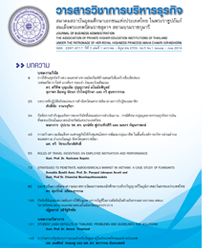การวิเคราะห์รูปแบบการออมสำหรับวัยสูงอายุในประเทศไทยและต่างประเทศ
Keywords:
รูปแบบการออม, กองทุนการออมแห่งชาติ, Saving Forms, National Savings FundAbstract
การศึกษาครั้งนี้ มีวัตถุประสงค์เพื่อวิเคราะห์รูปแบบการออมสำหรับวัยสูงอายุในประเทศไทยและต่างประเทศรวมทั้ง แนวนโยบายที่เหมาะสมให้ประชาชนสามารถเข้าถึงช่องทางการออม เพื่อให้มีรายได้เพียงพอในการเลี้ยงชีพโดยไม่มีภาวะพึ่งพิงเมื่อเข้าสู่วัยสูงอายุ และลดผลกระทบทางเศรษฐกิจและสังคม โดยผลการศึกษารูปแบบการออมในปัจจุบันของประเทศไทยตามกรอบแนวคิดของธนาคารโลก พบว่าประเทศไทยมีรูปแบบการออมครบทั้ง 5 เสาหลักซึ่งจำแนกตามรูปแบบการออมแบบให้เปล่า แบบบังคับ และแบบสมัครใจ และเมื่อวิเคราะห์ผลกระทบต่อผู้ออมทั้งความเพียงพอของเงินได้ ภาระการคลัง ความยั่งยืนของระบบการออม พบว่า ผลตอบแทนของการออมแต่ละแบบที่จัดสรรให้ผู้เกษียณอายุนั้น ไม่เพียงพอต่อการดำรงชีพหลังเกษียณ ยกเว้น ข้าราชการที่อยู่ในระบบบำนาญแบบเดิมและ กบข. ซึ่งมีรายได้ที่เพียงพอต่อการดำรงชีพหลังเกษียณ ดังนั้นจึงทำให้ผู้เกษียณมีความเสี่ยงที่จะอยู่ในภาวะยากจน หากไม่มีการออมเพิ่มเติมในระหว่างวัยทำงาน รวมถึงบางกองทุนพบว่ามีโอกาสที่จะมีเงินไม่เพียงพอที่จะจ่ายผู้เกษียณอีกด้วย รวมถึงผลต่อภาระการคลังของรัฐที่เพิ่มขึ้น จากการจัดสรรงบประมาณช่วยเหลือผู้สูงอายุสำหรับบางรูปแบบการออม โดยคาดว่าภาระงบประมาณด้านสวัสดิการชราภาพจะเพิ่มขึ้นอย่างต่อเนื่อง และประมาณการณ์ว่าในปี พ.ศ. 2558 ต้องใช้งบประมาณ 3.18 แสนล้านบาท ประกอบกับเมื่อพิจารณาความยั่งยืนของกองทุนการออมกลับพบว่า ประเทศไทยมีดัชนีความยั่งยืนของระบบบำนาญ (The Allianz Pension Sustainability Index: PSI)ในอันดับที่ต่ำที่สุดของเอเชียและของโลกจาก 50 ประเทศอีกด้วยผลการศึกษารูปแบบการบริหารจัดการการออมของต่างประเทศ พบว่า ประเทศที่กำลังพัฒนา เช่น ประเทศมาเลเซีย จะประสบปัญหาเช่นเดียวกับประเทศไทย คือ การที่มีประชากรอยู่นอกระบบทำให้สามารถสร้างความคุ้มครองคนกลุ่มเล็กเท่านั้น และรูปแบบบริหารจัดการระบบออมในประเทศที่ประสบความสำเร็จ มักจะกำหนดเป็นแบบ Multi-pillar pension system เพื่อให้สามารถจัดสรรเงินได้อย่างครอบคลุม แรงงาน ความเพียงพอของเงินได้หลังเกษียณ และความยั่งยืนของกองทุน
THE ANALYSIS OF SAVING FORMS FOR OLD AGE IN THAILAND AND FOREIGN COUNTRIES
The study aims to analyze saving forms for old age in Thailand and foreign countries including suitable policy that people can access, to earn sufficient income for cost of living without dependency during old age and to reduce economic and social impacts. According to the empirical result of current saving forms by the framework of The World Bank, Thailand has five pillars that can be classified into non-contributory, mandatory and voluntary saving forms. When analyzing the impacts of sufficient income, fiscal burden and saving sustainability on saving persons, the study suggests that the returns of each saving forms allocated to retired persons are insufficient for living after retirement except retired government official and government pension fund. Hence, retired persons are at risk to face poverty if there is no extra saving during working age. Moreover, some funds have insufficient money to pay to retired persons. Fiscal burden of the government also increases from the budget allocation to help senior citizens for some saving forms. It is expected that budget burden on senile welfare will increase continuously and require the budget of 3.18 million Baht in 2015. When considering the sustainability of saving fund, Thailand has the lowest rank of the Allianz Pension Sustainability Index (PSI) in Asia and the fiftieth rank in the world. The empirical result of saving management forms in foreign countries finds that developing countries such as Malaysia also face the same problem as Thailand that is informal citizenship can protect only a small group of people. The forms of saving system management in the successful countries are usually defined as multi-pillar pension system to allocate money for labor, sufficiency of income after retirement and sustainability of funds.
Downloads
How to Cite
Issue
Section
License
บทความที่ลงตีพิมพ์ในวารสารวิชาการบริหารธุรกิจ สมาคมสถาบันอุดมศึกษาเอกชนแห่งประเทศไทยต้องเป็นบทความที่ไม่เคยได้รับการตีพิมพ์เผยแพร่ หรืออยู่ระหว่างการพิจารณาตีพิมพ์ในวารสารอื่นๆ การละเมิดลิขสิทธิ์เป็นความรับผิดชอบของผู้ส่งบทความโดยตรง


